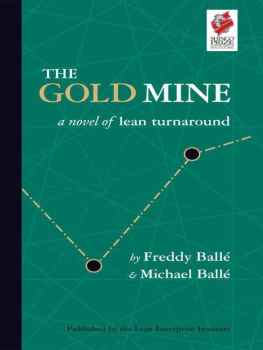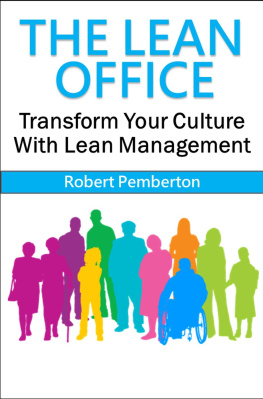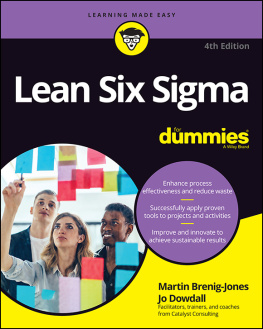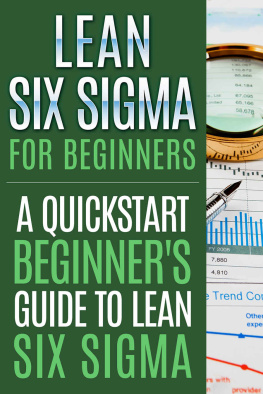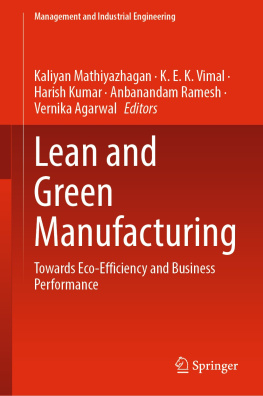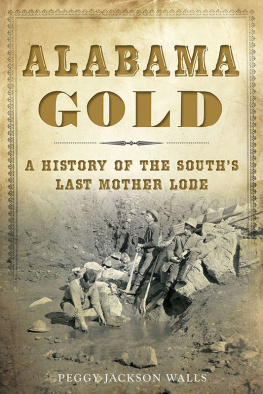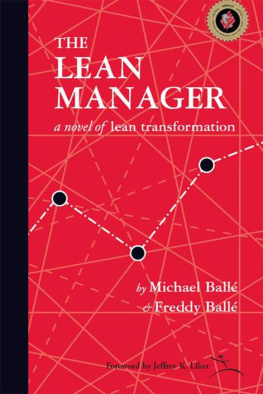| Lean Enterprise Institute |  |
Copyright 2005 Lean Enterprise Institute, Inc. All rights reserved.
Lean Enterprise Institute and the leaper image are registered trademarks of Lean Enterprise Institute, Inc.
Design by Off-Piste Design, Inc.
October 2009
Library of Congress Control Number: 2004117725
Ball, Freddy and Michael
The Gold Mine: a novel of lean turnaround/Freddy Ball and Michael Ball
ISBN: 0-9743225-6-3
This book is a work of fiction. Names, characters, businesses, organizations, places, events, and incidents either are the product of authors imaginations or are used fictitiously. Any resemblance to actual persons (living or dead), events, or locations is coincidental.
Lean Enterprise Institute, Inc.
One Cambridge Center
Cambridge, MA 02142 USA
(t) 617-871-2900 (f) 617-871-2999 lean.org
For Catherine and Florence
Contents
FOREWORD
Today the effectiveness of lean thinking has been well established. Companies from myriad industries in every corner of the world have proved that the principles are well founded. By posting record profits, while laying the basis for further growth, these companies, led by Toyota, reveal the promise of lean. Yet while these leaders appear enthusiastic and confident, for many others the reality of practicing lean management is a daunting challenge. Much of the technical basis for a lean transformation has been codified in an accessible manner, yet beyond the mechanics, managers often find the basic reasoning of the approach counter-intuitive. The necessary behavioral changes are stubbornly challenging, and often lead to doubts that undermine the prospective leader and team.
Freddy and Michael Balls book, The Gold Mine, serves to remove these doubts. Readers of this story will find in the all-too-human details of one lean turnaround a helpful reminder that this process takes more than technical prowess. More important, they will be inspired to use their natural talents to lead others to improve.
Over the last 20 years of implementing lean systems, from my position on the Board of GKN Automotive, then later at the helm of the Kaizen Institute, and currently as an advisor to McKinsey & Co., I have had the chance to work with many interesting and exciting people. While professional ethics should prevent me from having preferred clients, principles sometimes bow to reality. Having known and worked with Freddy for more than 10 years, I can say that he stands out as a remarkable combination of knowledge, drive, insight, and impact.
Working at the upper levels of the automotive industry is not for the faint-hearted. Freddy has always accepted the challenge of making change in an environment of unforgiving and unremitting pressure for results. He is legendary for the sophistication and intensity of his management of the budget process. But Freddy has never lost sight of his roots: the shop-floor, ground-up approach so critical to lean thinking. Exposing himself to the challenge of serving Toyota, he acquired a detailed knowledge of the specifics of the Toyota Production System that I believe is unequaled in senior management. Characteristically for Freddy and uncharacteristically for a senior manager, he used that knowledge as a means to instruct, challenge, and lead his managers through the lean transformation.
Together with his son, Michael, who has pursued his own successful consulting career, Freddy could have written an authoritative work on the technical aspects of lean implementation in the automotive components industry. Or they could have written what I suspect would be the definitive work on performance management for lean (which I hope that the success of this book will encourage them to do). Instead they chose to write the novel you now have in your hands.
This story is primarily about people, about how peoples minds have ideas about making things, and about how those ideas change based on their own perceptions, interests, and capabilities. This focus teaches lean at the point of use: the intersection of where we think, feel, and act. The authors have not lost sight of the fact that the tools and systems of lean are merely a codification of answers to specific questions that individuals have asked as they try to apply the basic principles.
The story is constructed like Alice in Wonderland. You can read and appreciate it as a simple piece of human drama, with a series of quirky and engaging characters, with twists and turns that will challenge and amuse you. You also can look below the surface to see a well-constructed framework that introduces and applies all of the tools of lean. Look even closer and you will see the basic beliefs on behavior, leadership, and problem solving that are the hidden aspects of a lean transformation.
The best thing about this book may be that you dont have to study it. Instead, sit back, read, and enjoy it, quite possibly using it for group reading with your colleagues. I guarantee that you will find that the lessons, turns of phrase, and pithy explanations will guide you on your own lean journey.
Peter Willats
Chapter One
PROFIT IS KING, BUT CASH RULES
First came the phone call. Mike? said Charlene. Is Phil with you? There was an edge to her voice, a hint of panic. Havent seen him, I answered. Is anything wrong?
I hope not. He phoned saying he would drop by your place in the evening, but I havent heard from him since. It was already past 11 p.m. by my watch, reason enough to be worried but not quite that worried. I tried to get her to talk some more, but she just asked me to ring if Philip came around. I put the phone down, puzzled. Philip Jenkinson is a close friend. We go all the way back to senior high, and wed had a drink only a few weeks ago. He was the successful one. Hed made it big in the world. Hed made it rich. I knew he had been under a lot of work pressure lately, but beyond the usual signs of executive stress, he seemed perfectly fine. I worried he may have had an accident.
The front doorbell rang. A disgruntled cab driver was trying to steer a drunken Philip, who was swaying and blabbering. This your friend? grunted the cabby. We lugged Phil inside and dropped him on the couch. He was not only deeply under the influence, but shivering badly, and soaked from the driving rain. I paid the driver, added a tip, and watched him retreat into the filthy night. Philip was already snoring. Feeling like a snitch, I phoned Charlene, remained vague on the details, and told her not to worry, Id drive her husband back to her in the morning. I could hear the kids bickering in the background and was surprised that they were still up at this time, unusual on a weekday, but after all, it was none of my business.
I pulled the drenched coat off Philip, battled with his boots, and left him to sleep it off spread-eagled on the sofa. He looked strangely childish, mumbling in his drunken stupor, an echo of the gangling teenager hed been in our youth, and, not for the first time, I wondered why on earth hed retained the nerd-like haircut-and-glasses look of his teens. He even had pens sticking out of his shirt pocket! He was a big man, tall, blond, with strong features marred somewhat by pockmarks. A good face, though, and a good man, I reminded myself, irritated. Not particularly subtle or refined, hed been a good friend over the years terribly sharp in his own one-dimensional way. Slightly on the boring side, he rarely drank, never smoked, and, aside from a weakness for flashy cars and a compulsion to work, had no particular vices to speak of. What, I wondered, had got him into this dreadful state?

